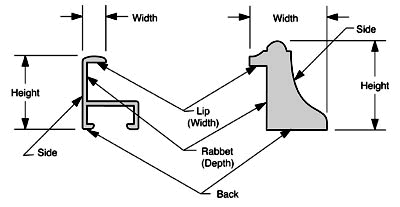 |
Figure 1 — Common frame terminology |
Allowance - the difference between the size of a frame (like 16x20) and the actual size of the opening on the back of the frame that accepts the art. It is usually 1/8 inch (so it would measure 16 1/8 x 20 1/8) This is to "allow" for errors in measuring, marking, cutting, and squareness of all the materials that make up a frame. Frames made in Asia and Europe usually use 2mm "Allowance" which is a little larger than 1/16 inch. If your glass is not square for example, it will eat up allowance. The allowance is mostly critical using FrameSpace because FrameSpace adds almost 1/16 inch to the size of the glass.
Acid Free - A marketing term to sell you stuff. The correct thing to know about framing materials is the pH. Neutral pH is around 7. Ask the manufacturers what is the pH of their product is.
Acid Free Tape - (See Acid Free above) They don't add acid to any tape. What they do add are plasticizers and other chemicals to keep the tape gooey. The goo is pressed into the paper fibers and then dries out and becomes hardened with age. It becomes almost impossible to remove without damage to the paper from the solvents used to remove it. No pressure sensitive tapes can be considered permanent (except for the lasting affect on the art).
Neutral pH - Now here's a term we can use. (See Acid Free above).
Archival - Another marketing term used to sell you stuff. An archive is a place where important document or materials are stored. To say that a material is archival is to imply that it will not alter or otherwise harm the object. Again, ask what is the pH? Can it be removed without affecting the object? There are no pressure sensitive or water activated tapes that are safe to use to attach art in a frame. Even if they're called "Archival".
Museum - Yet another marketing term used to sell you stuff. Museums have no universal written standards for material specifications. Sellers are inferring that their stuff is used in museums and so it must be OK for your art. What is the pH? How can it be removed? What are the long term affects on the art. Which museums and what are they using it for? - specifically.
Plasticizer Free - Another good term. Plasticizers are added to plastics and adhesives to keep them flexible. Plasticizers will usually leave like an oil stain on paper and may also turn stuff brown.
Barrier paper - Paper is too porous to be a barrier against acid migration. 4 ply rag mats are also too porous to be a barrier against acid migration. Metal and glass make great barriers.
Conservation or conservation grade - another marketing term to sell you stuff. Conservators have no universal standards or criteria for specifying any materials. Inference again.
Preservation - Preservation Framing - The use of materials and methods that will "preserve" the art or object. This method should be completely reversible without harm to the art. |
